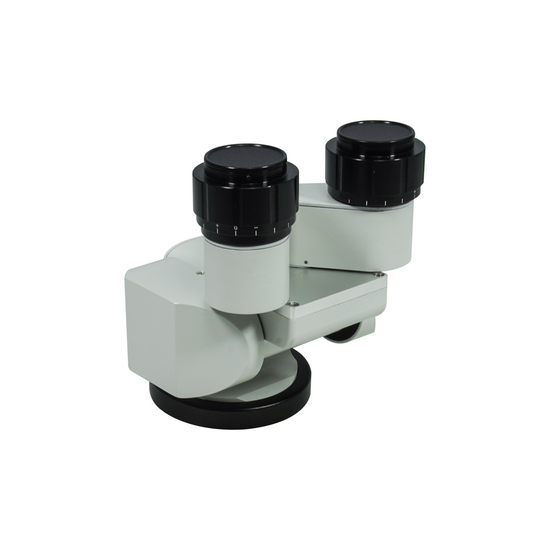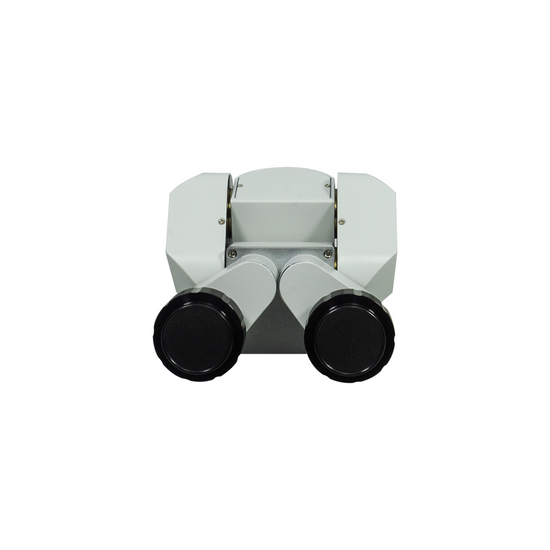Quick Overview
Infinite. For Stereo Microscope. Eye Tube Angle: 0-90°. Eye Tube Inner Diameter: Dia. 30mm. Eye Tube Diopter Adjustable: ±5°. Standard Eyepiece. Eyepiece Optical Magnification: 12.5X. Eyepiece Size for Eye Tube: Dia. 30mm. Eyepiece Field of View: Dia. 18mm. For PZ0401, PZ1701 Series Parallel Zoom Stereo Microscope.
PZ02312521 0-90° Stereo Binocular Head
Stereo Binocular Head
| Eye Tube Optical System | Infinite |
| Eye Tube Type | For Stereo Microscope |
| Eye Tube Adjustment Mode | Siedentopf |
| Eye Tube Angle | 0-90° |
| Erect/Inverted Image | Erect image |
| Eye Tube Rotatable | 360° Degree Rotatable |
| Interpupillary Adjustment | 45-90mm |
| Eye Tube Inner Diameter | Dia. 30mm |
| Eye Tube Diopter Adjustable | ±5° |
| Eye Tube Fixing Mode | Locking Screw |
| Eye Tube Size for Scope Body/Carrier | Dia. 60mm |
| Surface Treatment | Spray Paint |
| Material | Metal |
| Color | Gray |
| Net Weight | 1.27kg (2.80lbs) |
| Applied Field | For PZ0401, PZ1701 Series Parallel Zoom Stereo Microscope |
Eyepiece
| 12.5X Eyepiece (Pair Dia. 30/FN18) | |
| Eyepiece Type | Standard Eyepiece |
| Eyepiece Optical Magnification | 12.5X |
| Plan Eyepiece | Plan Eyepiece |
| Eyepiece Size for Eye Tube | Dia. 30mm |
| Eyepiece Field of View | Dia. 18mm |
| Eyepoint Type | High Eyepoint Eyepiece |
| Surface Treatment | Electroplating Black |
| Material | Metal |
| Color | Black |
| Net Weight | 0.12kg (0.26lbs) |
Technical Info
Instructions
Microscope Eyepiece TubeClose Λ
| Microscope eyepiece tube, is also called eyetube, or microscope observation tube. Microscope eyepiece tube, usually referred to the microscope eyepiece tube and the part of the connecting body, which, for some, is attached to the body, and for some others, separated from the microscope. When separated, a screwdriver or wrench is required in order to secure it to the microscope body. The eyepiece of the microscope is, sometimes, carried in the eyepiece tube, and fixed by screws, and for some, it is separated, to facilitate selecting and mounting eyepieces of different magnifications. When mounting, it needs to be mounted again upon the eyepiece tube. |
InfiniteClose Λ
| Microscopes and components have two types of optical path design structures. One type is finite optical structural design, in which light passing through the objective lens is directed at the intermediate image plane (located in the front focal plane of the eyepiece) and converges at that point. The finite structure is an integrated design, with a compact structure, and it is a kind of economical microscope. Another type is infinite optical structural design, in which the light between the tube lens after passing the objective lens becomes "parallel light". Within this distance, various kinds of optical components necessary such as beam splitters or optical filters call be added, and at the same time, this kind of design has better imaging results. As the design is modular, it is also called modular microscope. The modular structure facilitates the addition of different imaging and lighting accessories in the middle of the system as required. The main components of infinite and finite, especially objective lens, are usually not interchangeable for use, and even if they can be imaged, the image quality will also have some defects. The separative two-objective lens structure of the dual-light path of stereo microscope (SZ/FS microscope) is also known as Greenough. Parallel optical microscope uses a parallel structure (PZ microscope), which is different from the separative two-object lens structure, and because its objective lens is one and the same, it is therefore also known as the CMO common main objective. |
SiedentopfClose Λ
| For siedentopf eyetube, when changing the interpupillary distance, it requires two hands pushing or pulling the two eyetubes left and right simultaneously, and the two eyepiece tubes or eyetubes will change their position at the same time. |
Eye Tube AngleClose Λ
| Usually the Microscope Eyetube is 45°, some is 30°, Tiltable Eyetube Angle design of a microscope is also known as the ergonomics microscope. 0-30° or 0-45° is an ergonomic design. When the mechanical tube length / focal length of the tube of the microscope is relatively big, the microscope is relatively high, and the user's height or the seat of the work desk is not suitable, long-term use of microscope may cause sitting discomfort. Eyepiece tube with variable angle can freely adjust the angle without lowering the head. Especially when it is close to 0 degree and the human eye is close to horizontal viewing, long-time or long-term use can avoid fatigue damage to the cervical vertebra. |
Erect/Inverted ImageClose Λ
| After imaging through a set of objective lenses, the object observed and the image seen by the human eye is inverted. When the observed object is manipulated, move the specimen or object, the image will move in the opposite direction in the field of view. Most of the biological microscopes are reversed-phase designs. When needing to operate works with accurate direction, it is necessary to design it into a forward microscope. Generally stereo microscopes and metallurgical microscopes are all of erect image design. When observing through the camera and display, the erect and inverted image can be changed by the orientation of the camera. |
360° Degree RotatableClose Λ
| The eyepiece of the microscope can have different viewing or observing directions. When the position of the microscope is uncomfortable, the direction of the eyepiece tube of the microscope can be adjusted, to facilitate observation and operation. Placement method of different viewing angles of the microscope: General direction: the support column is behind the object to be observed Reverse direction: the support column is in front of the object to be observed Lateral direction: the support column is on the side of the object to be observed Rotating eyepiece tube, different microscopes may have different methods, for some, the direction is confirmed when installing the eyepiece tube of the microscope, for some, by rotating the body of the microscope, and for some, by rotating the support member on the support or holder of the microscope. |
Interpupillary AdjustmentClose Λ
| The distance between the two pupils of the human eye is different. When the image of exit pupil of the two eyepieces of the microscope are not aligned with the entry pupil of the eye, the two eyes will see different images, which can cause discomfort. Adjust the distance between the two eyepieces, to accommodate or adapt to the pupil distance of the observer's eyes. The adjustment range is generally between 55-75mm. |
Eye Tube Diopter AdjustableClose Λ
| For most people, their two eyes, the left and the right, have different vision; for the eyepiece tube, the eyepoint height of the eyepiece can be adjusted to compensate for the difference in vision between the two eyes, so that the imaging in the two eyes is clear and consistent. The range of adjustment of the eyepiece tube is generally diopter plus or minus 5 degrees, and the maximum differential value between the two eyepieces can reach 10 degrees. Monocular adjustable and binocular adjustable: some microscopes have one eyepiece tube adjustable, and some have two eyepiece tubes adjustable. First, adjust one eyepiece tube to the 0 degree position, adjust the microscope focusing knob, and find the clear image of this eyepiece (when the monocular adjustable is used, first adjust the focusing knob to make this eyepiece image clear), then adjust the image of another eyepiece tube (do not adjust the focusing knob again at this time), repeatedly adjust to find the clear position, then the two images are clear at the same time. For this particular user, do not adjust this device anymore in the future. As some microscopes do not have the vision adjustment mechanism for the eyepiece tube, the vision of the two eyes are adjusted through the eyepiece adjustable. |
Eyepiece Optical MagnificationClose Λ
| Eyepiece optical magnification is the visual magnification of the virtual image after initial imaging through the eyepiece. When the human eye observes through the eyepiece, the ratio of the tangent of the angle of view of the image and the tangent of the angle of view of the human eye when viewing or observing the object directly at the reference viewing distance is usually calculated according to 250 mm/focal length of eyepiece. The standard configuration of a general microscope is a 10X eyepiece. Usually, the magnification of the eyepiece of compound microscope is 5X, 8X, 10X, 12.5X, 16X, 20X. As stereo microscope has a low total magnification, its eyepiece magnification generally does not use 5X, but can achieve 25X, 30X and other much bigger magnification. |
Eyepiece Field of ViewClose Λ
| The eyepiece field of view is the diameter of the field diaphragm of the eyepiece, or the diameter of the image plane of the field diaphragm imaged by the field diaphragm. The diameter of a large field of view can increase the viewing range, and see more detail in the field of view. However, if the field of view is too large, the spherical aberration and distortion around the eyepiece will increase, and the stray light around the field of view will affect the imaging effect. |
Eyepoint TypeClose Λ
| Eye point refers to the axial distance between the upper end of the metal frame of the eyepiece and the exit of pupil. The exit of pupil distance of high eyepoint eyepiece is farther than that of the eye lens of the ordinary eyepiece. When this distance is greater than or equal to 18mm, it is a high eyepoint eyepiece. When observing, one does not need to be too close to the eyepiece lens, making it comfort to observe, and it can also be viewed with glasses. Generally, there is a glasses logo on the eyepiece, indicating that it is a high eyepoint eyepiece. |
PackagingClose Λ
| After unpacking, carefully inspect the various random accessories and parts in the package to avoid omissions. In order to save space and ensure safety of components, some components will be placed outside the inner packaging box, so be careful of their inspection. For special packaging, it is generally after opening the box, all packaging boxes, protective foam, plastic bags should be kept for a period of time. If there is a problem during the return period, you can return or exchange the original. After the return period (usually 10-30 days, according to the manufacturer’s Instruction of Terms of Service), these packaging boxes may be disposed of if there is no problem. |
| Contains | ||||
| Parts Including |
|
| Packing | |
| Packaging Type | Carton Packaging |
| Packaging Material | Corrugated Carton |
| Packaging Dimensions(1) | 31x22.5x36.5cm (12.205x8.858x14.370″) |
| Inner Packing Material | Plastic Bag |
| Ancillary Packaging Materials | Expanded Polystyrene |
| Gross Weight | 1.75kg (3.86lbs) |
| Minimum Packaging Quantity | 1pc |
| Transportation Carton | Carton Packaging |
| Transportation Carton Material | Corrugated Carton |
| Transportation Carton Dimensions(1) | 31x22.5x36.5cm (12.205x8.858x14.370″) |
| Total Gross Weight of Transportation(kilogram) | 1.75 |
| Total Gross Weight of Transportation(pound) | 3.86 |
| Quantity of One Transportation Carton | 1pc |






















